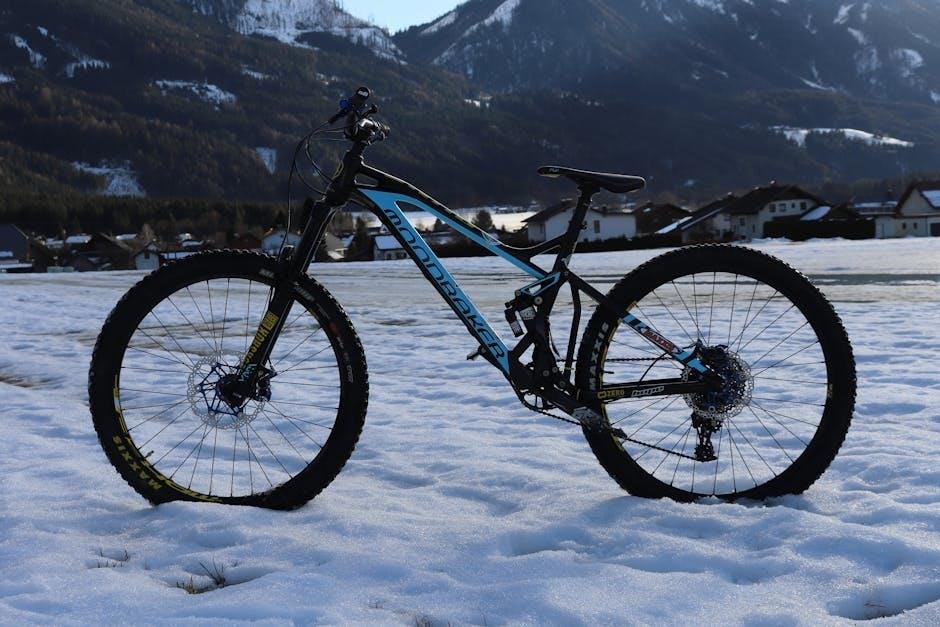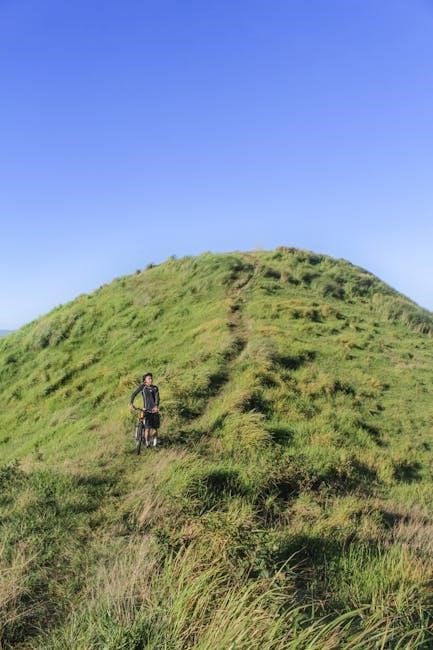
Finding the right size Specialized mountain bike is crucial for optimal comfort and performance on trails. A well-fitted bike enhances control, reduces fatigue, and maximizes your enjoyment of the ride, ensuring a perfect blend of bike and rider.
Importance of Correct Bike Size
Selecting the correct size Specialized mountain bike is paramount for a comfortable and efficient riding experience. An improperly sized bike can lead to discomfort, pain, and reduced control, ultimately diminishing your enjoyment on the trails. The right size ensures optimal power transfer, allowing you to tackle climbs and navigate descents with confidence. Proper fit also minimizes the risk of injury by promoting a balanced and ergonomic riding position. It enhances bike handling and responsiveness, enabling you to react quickly to changing terrain and obstacles. Choosing the correct size is a key factor in unlocking your full potential and having fun.

Understanding Specialized’s S-Sizing System
Specialized’s S-Sizing offers a different approach to bike sizing, focusing on ride feel over traditional height-based sizing. It allows riders to choose a size based on desired handling characteristics and riding style.
What is S-Sizing?
S-Sizing, introduced by Specialized in 2018, is a mountain bike sizing system that moves away from traditional height-based sizing. Instead of focusing solely on rider height, S-Sizing uses frame reach and standover height to determine the appropriate size. This allows riders to select a bike based on their preferred riding style and handling characteristics. S-Sizes (S1, S2, S3, etc.) offer similar headtube lengths, letting riders prioritize maneuverability or stability over conventional size metrics. It’s found on Stumpjumpers, Enduros, Demos, Levos, and Kenevos.
Benefits of S-Sizing
S-Sizing offers several advantages over traditional sizing methods. It allows riders to fine-tune their bike’s handling based on personal preferences. Smaller S-Sizes provide a more nimble and playful ride due to their shorter reach, making them ideal for technical trails and quick maneuvers. Larger S-Sizes offer increased stability and a more spacious cockpit, enhancing confidence on high-speed descents and challenging terrain. This system accommodates varying body proportions, ensuring a better fit for riders with different torso and leg length ratios, leading to improved comfort and control.

Specialized Mountain Bike Models and Sizing Charts
Specialized offers a range of mountain bikes, each with its specific sizing chart. These charts assist riders in selecting the appropriate frame size based on height and riding style for optimal performance.
Trail Bikes (e.g., Stumpjumper, Stumpjumper Evo)
Specialized trail bikes, like the Stumpjumper and Stumpjumper Evo, utilize S-Sizing. This system focuses on reach and riding style rather than traditional height-based sizing. S-Sizing offers similar headtube lengths and standover heights across sizes, letting riders choose based on desired handling. A smaller size provides nimble handling, while a larger size offers increased stability. Consider your preferred riding style and terrain when selecting an S-Size for your trail bike. Consult the specific model’s sizing chart for accurate recommendations.
Enduro Bikes (e.g., Enduro)
Specialized Enduro bikes are also equipped with S-Sizing, emphasizing maneuverability and stability. Riders can select a size that complements their riding style and the challenging terrain they tackle. Choosing a smaller S-Size will offer a more playful and agile feel, excelling in tight corners and technical sections. Conversely, a larger S-Size will prioritize stability at high speeds and on rough descents, providing a more planted and confident ride. Always refer to the official Specialized Enduro sizing chart for precise measurements and recommendations based on your individual needs.
Downhill Bikes (e.g., Demo)
Specialized Demo downhill bikes utilize S-Sizing to cater to the demands of aggressive riding. Selecting the appropriate size is critical for control and confidence when tackling steep descents and challenging obstacles. A smaller size promotes maneuverability, allowing for quick adjustments and responsive handling. A larger size enhances stability at high speeds, providing a more secure and planted feel. Factors like reach and front-center measurement play a key role in determining the ideal size based on rider preference and terrain. Review the Specialized Demo sizing chart for detailed guidance.

Factors Beyond Height
While height is a starting point, other body dimensions significantly influence bike fit. Torso length, leg length, and arm reach play critical roles in determining the ideal frame size and ensuring comfortable, efficient riding.
Torso and Leg Length Ratio
The ratio between your torso and leg length is a significant factor beyond overall height when choosing a Specialized mountain bike. Individuals with longer torsos may prefer a bike with a longer reach to avoid feeling cramped, even if their height suggests a smaller size. Conversely, those with longer legs might opt for a shorter reach for better control and maneuverability. Considering this ratio ensures a more personalized and comfortable fit, optimizing your riding experience on varied terrains.
Arm Length and Reach
Arm length plays a vital role in determining the ideal reach on your Specialized mountain bike. A longer arm span typically benefits from a longer reach, providing a more comfortable and balanced riding posture. Conversely, shorter arms may necessitate a shorter reach to prevent overextension and maintain optimal control. It’s crucial to consider your arm length relative to the bike’s reach to ensure efficient power transfer and prevent strain, ultimately enhancing your performance and enjoyment on the trails, allowing a more natural feel.

How to Use the Size Chart Effectively
Effectively utilizing Specialized’s mountain bike size chart is key to finding the perfect fit. Accurate measurements combined with understanding chart details will guide you toward optimal bike size selection.
Locating the Correct Size Chart
Begin by identifying the specific Specialized mountain bike model you’re interested in, such as the Stumpjumper, Enduro, or Demo. Navigate to Specialized’s official website or authorized retailer sites. Find the dedicated product page for your chosen model. On this page, look for a section labeled “Size Chart” or “Geometry.” Ensure the size chart corresponds to the correct model year of the bike, as specifications can vary. This precise chart will provide crucial measurements for accurate sizing.
Interpreting Measurements (Reach, Stack, Standover Height)
Understanding reach, stack, and standover height is key to interpreting size charts. Reach indicates the horizontal distance from the bottom bracket to the head tube, influencing riding posture. Stack refers to the vertical distance, affecting handlebar height. Standover height is the distance from the ground to the top tube, ensuring clearance while standing. Compare these measurements with your body dimensions for an accurate assessment. Prioritize reach and stack for comfortable cockpit positioning and effective handling.
Riding Style and Size Preference
Your riding style and personal preferences significantly impact your ideal bike size. Aggressive riders might prefer smaller frames for agility, while those seeking stability may opt for larger ones, tailoring the ride to their needs.
Nimble vs. Stable Ride
The size of your mountain bike directly influences its handling characteristics, impacting whether it feels nimble or stable. Smaller frames generally offer increased agility and responsiveness, making them ideal for tight, technical trails where quick maneuvers are essential. Conversely, larger frames tend to provide enhanced stability, especially at higher speeds or on rougher terrain, allowing for a more confident and controlled ride. Ultimately, the choice depends on your preferred riding style and the type of trails you frequent. Consider what matters most: quick turns or steadfast control.
Sizing Up vs. Sizing Down
Deciding whether to size up or size down from the recommended size can significantly impact your riding experience. Sizing up often provides a more stable feel, offering greater confidence at higher speeds and on descents. This can be beneficial for riders prioritizing stability and downhill performance. Conversely, sizing down can result in a more playful and maneuverable bike, excelling in tight corners and technical sections. This is often preferred by riders who value agility and responsiveness. Consider your riding style and the terrain you typically encounter to make the best choice.
Professional Bike Fitting
A professional bike fitting offers personalized adjustments beyond standard sizing. Experts analyze your body mechanics to optimize comfort, power, and efficiency, ensuring your Specialized mountain bike fits you perfectly for enhanced performance.
Benefits of a Professional Fitting
Investing in a professional bike fit for your Specialized mountain bike offers numerous advantages. It goes beyond basic size charts, addressing individual biomechanics for enhanced comfort and efficiency. A proper fit minimizes the risk of injuries, such as knee pain or back strain, by optimizing your riding posture. Furthermore, it maximizes power output, allowing you to climb hills and navigate trails with greater ease and reduced fatigue. Ultimately, a professional fitting elevates your overall riding experience and helps unlock your full potential.
What to Expect During a Fitting
A professional Specialized mountain bike fitting typically begins with an assessment of your riding history, flexibility, and any physical limitations. The fitter will then observe you riding on a stationary bike or your own bike on a trainer, analyzing your posture, pedal stroke, and overall movement. Using specialized tools and software, they’ll measure key angles and distances to optimize saddle height, handlebar position, and cleat placement. Expect adjustments to be made iteratively, with feedback from you to fine-tune the fit for maximum comfort, efficiency, and control on the trails.
Ultimately, the perfect Specialized mountain bike fit is a personalized experience. By considering all factors and potentially seeking professional guidance, you can unlock your full potential and enjoy every ride.
Recap of Key Considerations
Before making a final decision, remember the importance of Specialized’s S-Sizing, which prioritizes ride feel over traditional height-based sizing. Consider your torso and leg length, as well as arm length and reach, for a balanced fit. Refer to the size chart, paying attention to reach, stack, and standover height. Factor in your riding style and whether you prefer a nimble or stable ride. If unsure, a professional bike fit can provide invaluable insights.
Final Recommendations
Ultimately, the best Specialized mountain bike size is the one that feels right for you. Don’t hesitate to test ride different sizes and models to get a sense of their handling. If you’re between sizes, consider your riding style and preferences. A smaller size offers more agility, while a larger size provides increased stability. Invest time in understanding the nuances of Specialized’s sizing system and how it applies to your individual needs for the best possible trail experience.